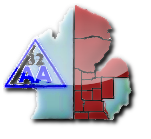What is an Intergroup or Central Office?
Your Intergroup (also known as your “Central Office”) is often where the sick alcoholic first calls or shows up for A.A. help.
How does it function? Local Intergroups (or Central Offices) are independent of A.A.’s worldwide service structure [i.e, the Groups , the District Committees, the Area Assemblies and the General Service Conference ], but they are a vital part of the Fellowship. A local Intergroup is supported by voluntary contributions from its member groups. Most Intergroups and Central offices function with only one or two paid workers; they rely heavily on A.A. volunteers for help. Many A.A.s have found that serving at Intergroup or Central offices -- answering calls from alcoholics and doing what else needs to be done -- greatly enriches their sobriety and broadens their circle of friends.
What does an Intergroup do? Methods and goals vary from one area to another, but generally, the primary purpose of an Intergroup is to:
- Respond to phone or walk-in requests for help from sick alcoholics and, when appropriate, arrange for A.A. volunteers to accompany them to an A.A. meeting.
- Maintain “A.A.” listings in local phone directories, handle phone and mail inquiries, and route them to local groups, thus distributing Twelfth-Step work on a geographical basis so that newcomers are assured of help.
- Distribute up-to-date meeting lists.
- Stock and sell A.A. literature.
- Serve as a communications center for participating groups—often issuing regular newsletters or bulletins to keep groups informed about one another.
- Arrange systems for groups to exchange speakers.
- Coordinate the efforts of its service committees.
- Sometimes provide information on treatment facilities, hospitals and halfway houses.
- Handle requests for information about A.A. from local news media, arrange local radio or TV programs about A.A., and furnish speakers for schools and non-A.A. organizations.
- Cooperate with local group, District and Area committees.
- Maintain communication and cooperation — but not affiliation—with the community and helping professionals in the field of alcoholism.
What does AAWS say about Intergroups?
From AA pamphlet P-16, "The A.A. Group...Where it all begins":
Working with Local Intergroups and Central Offices
Traditionally, general service committees and intergroups/central offices have performed different functions. Central offices provide local services; general service committees maintain the link between the AA groups and the AA General Service Board by means of the Conference. So these two separate but vital service structures coexist in many areas in mutual cooperation and harmony.
At the time the Conference was started, there were already well-established central offices in several large cities, providing service for local AA groups and members. Today, there are many more central offices throughout the US and Canada, supported by the AA groups in the communities they serve. Each group elects a representative to attend central office meetings.
These offices provide such services as:
- Receiving, arranging, and following up Twelfth Step calls.
- Answering inquiries about AA.
- Establishing local public information committees.
- Maintaining information about local hospitals and recovery facilities for alcoholics.
- Publishing local AA meeting lists.
- Providing a newsletter.
- Ordering, selling and distributing AA Conference-approved literature.
In contrast, the Conference structure is the method through which all AA groups in an area can provide the most effective communication within the area and between the groups and the General Service Board and GSO on matters of policy that affect AA as a whole. These include policy on: Conference-approved literature, AA public information, AA cooperation with the professional community, AA activity in treatment and correctional facilities, AA finances, the AA Grapevine, and the election of trustees to the General Service Board.
Many areas find that a liaison between the central office/intergroup and the area committee is very helpful in maintaining good relations and communication. In some areas the liaison has a vote at the assembly; in others, a voice but no vote.
More information on working together is available through GSO and in the pamphlets The AA Group and Self-Support: Where Money and Spirituality Mix, as well as in the Guidelines on Intergroups/Central Offices.
Reprinted with permission from the book The A.A. Service Manual, ©2004 AA World Services, Inc., Pg. S37-S38

